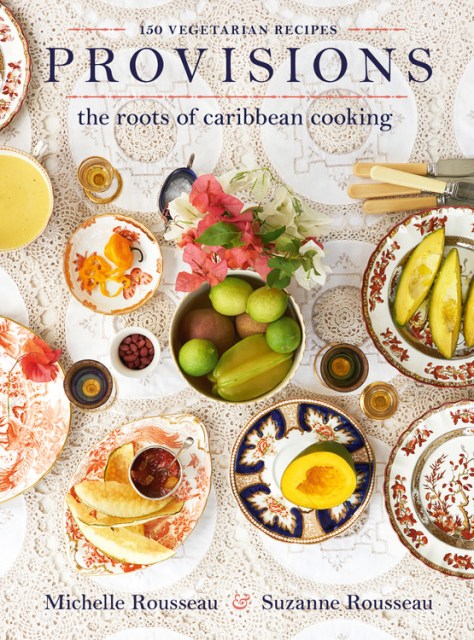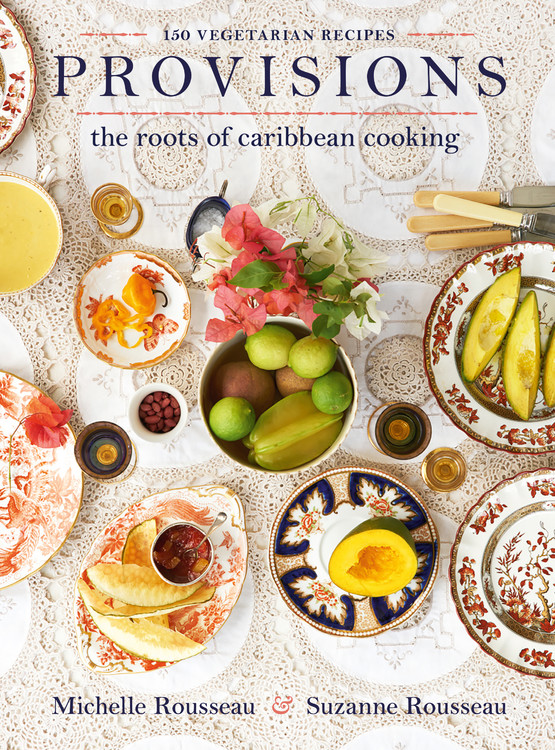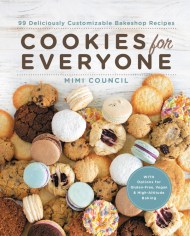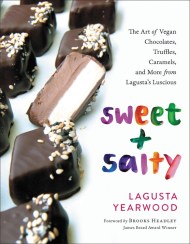Promotion
Use code BEST25 for 25% off storewide. Make sure to order by 11:59am, 12/12 for holiday delivery!
By clicking “Accept,” you agree to the use of cookies and similar technologies on your device as set forth in our Cookie Policy and our Privacy Policy. Please note that certain cookies are essential for this website to function properly and do not require user consent to be deployed.
Provisions
The Roots of Caribbean Cooking -- 150 Vegetarian Recipes
Contributors
Formats and Prices
- On Sale
- Oct 30, 2018
- Page Count
- 320 pages
- Publisher
- Balance
- ISBN-13
- 9780738234670
Price
$30.00Price
$39.00 CADFormat
Format:
Hardcover $30.00 $39.00 CADThis item is a preorder. Your payment method will be charged immediately, and the product is expected to ship on or around October 30, 2018. This date is subject to change due to shipping delays beyond our control.
Buy from Other Retailers:
In Provisions, Michelle and Suzanne Rousseau share 150 recipes that pay homage to the meals and market produce that have been farmed, sold, and prepared by Caribbean people — particularly the women — for centuries. Caribbean food is often thought of as rustic and unrefined, but these vibrant vegetarian dishes will change the way we think about this diverse, exciting, and nourishing cuisine. The pages are spiced with the sisters’ fond food memories and fascinating glimpses of the islands’ histories, bringing the region’s culinary past together with creative recipes that represent the best of Caribbean food today.
With a modern twist on traditional island ingredients and flavors, Provisions reinvents classic dishes and presents innovative new favorites, like Ripe Plantain Gratin, Ackee Tacos with Island Guacamole, Haitian Riz Djon Djon Risotto, Oven-Roasted Pumpkin Flatbread, and Caramelized Fennel and Grilled Green Guava with Mint. Stunning full-color photographs showcase the variety of these dishes: hearty stews, easy one-pot meals, crunchy salads, flavorful pickles, preserves, and hot sauces, sumptuous desserts, cocktails, and more. At once elegant, authoritative, and accessible, Suzanne and Michelle’s recipes and stories invite you to bring fresh Caribbean flavors to your table.
-
Provisions is an elegant balance of heritage and health. This comprehensive book celebrates the plant-based flavors of the pan-Caribbean basin and the spectacular ways in which the intellect and aesthetic of the Islands impact one of its most enduring legacies...its plates. The authors have produced an heirloom volume.Michael W. Twitty, author of The Cooking Gene and creator of Afroculinaria
-
Sustaining legacy is the highest power of any cookbook. Provisions stands on the shoulders of all of the women who came before Suzanne and Michelle Rousseau. This is not only an important book, it's also a beautiful and useful one. You'll find yourself making a grocery list in no time.Julia Turshen, author of Now & Again, Feed the Resistance, and Small Victories
-
Our female forbearers traveled to extraordinary lengths to nourish others with ordinary, often overlooked ingredients, in the most challenging circumstances. To grow, cook, and sell the food of the earth is the very definition of necessity breeding invention. In the tradition of generations of strong woman cooks, Michelle and Suzanne continue to innovate with these modern and craveably delicious recipes.Lucinda Scala Quinn, chef, author, and host of Mad Hungry: Bringing Back the Family Meal
-
If you love cookbooks with a strong dash of storytelling, you'll love Provisions from sisters Michelle and Suzanne Rousseau. They pay tribute to their family matriarchs and explain the history behind their favorite classic and contemporary Caribbean recipes.Kerry Diamond, editor-in-chief of Cherry Bombe
-
Engaging, informative, and as witty as the play on words hidden in its full title, Provisions: The Roots of CaribbeanCooking takes the reader on a tour of the region's food. Packed with recipes that made me want to head to the nearest market, taste memories that made me dream of the islands, a brief history of their family and of Caribbean food, and a glossary of local ingredients, it is simply a Caribbean vacation between two covers.Jessica B. Harris, PhD, author, food historian, lecturer, professor (retired)
-
This book is truly special. At a time when women aren't celebrated enough in the culinary world, Provisions shows that women have always been the backbone of every facet of food. The recipes paint a picture of the flavors in 'mi grand mudda's kitchen' but with a modern and refreshing approach.Jerome Grant, executive chef, Sweet Home Café
-
Provisions is so much more than a collection of recipes. This rich and fulfilling work of art takes us deep into the minds and kitchens of the resilient, brave and genius women of the Caribbean. Michelle and Suzanne creatively pay homage to the past while bringing the recipes and ingredients back to life with their modern interpretations.Rock Harper, founder and president, RockSolid Creative Food Group
-
"[A] diverse, spot-on collection of 150 vegetarian recipes...Filled with satisfying warm-weather recipes, this is best enjoyed with a fruity rum-based cocktail close by."Publishers Weekly
-
"Designed to highlight the fresh produce of the West Indies, most recipes use fairly straightforward techniques that will be familiar to home cooks. An indispensable guide to sourcing, preparing, and substituting ingredients accompanies extensive historical background that places recipes in the context of slavery's legacy in the region. Vibrant photography perfectly accentuates the bright flavors of the food, creating a sublime mix of inspiration and practical knowledge that will appeal to all creative home cooks. Not to be missed; an essential purchase for library cookery collections."Library Journal (starred review)
-
"An ode to culinary matriarchs and a welcome reconsideration of the culinary legacy of the Caribbean."New Yorker (The Best Food Books of 2018)
-
"The Caribbean-inspired vegetarian recipes by sister authors Michelle and Suzanne Rousseau are appetizing, but what truly makes this book-named after the provision grounds that were allocated to slaves by plantation owners-special is the Rousseau sisters' plunge into the history of the women behind Caribbean cooking. With great love and care, the Rousseaus shed light on those who have for too long 'been forgotten, unacknowledged, and unseen.'"San Francisco Chronicle ("The Best Cookbooks of 2018")
-
"A lush and artful work-one part cookbook, one part canonical and historical text. A modern collection of vegetarian comfort-food recipes, the book details the lineage of the invisible contributions of African women, and the savvy meal refinement of their descendants, self-reliant and creative West Indians who innovated the region's most beloved foodstuffs."The Atlantic
-
"Part-historical reference, part-cookbook, Provisions balances the story of bounty and bareness of the country's colonial history, with an imaginative rethink of flavour combinations that now define what the Rousseaus call 'modern heritage dining'...Something for every taste, whether casual veggie lover or avowed vegetarian."Jamaica Observer
-
"With Provisions, [Michelle and Suzanne Rousseau] further cement their legacy not only as ambassadors of Caribbean foodways but also as preservers of its history...Inspired by the literal roots of Caribbean cooking, Provisions is as much a beautiful meditation on what the sisters cook today as it is an homage to all the women who have stood in kitchens stirring pots to feed their communities before them."Bon Appetit's Healthyish
-
"Michelle and Suzanne Rousseau give us not just a new way to cook, but a new way to think about how recipes come to be in the first place."Epicurious
-
"For those who want to delve further into Caribbean cuisine, look for Provisions: The Roots of Caribbean Cooking by Michelle Rousseau and Suzanne Rousseau, full of recipes using traditional Caribbean ingredients such as cassava, ackee, plantains, guava and mango."Atlanta Journal-Constitution
-
"Like most recent cookbook writers, the sisters have family stories to tell, along with updated family recipes to relate...The photographs are tantalizing."Milwaukee Shepherd-Express
-
"Vibrant vegetarian dishes...With a modern twist on traditional island ingredients and flavors, Provisions reinvents classic dishes and presents innovative new favorites... At once elegant, authoritative, and accessible, Suzanne and Michelle's recipes and stories invite you to bring fresh Caribbean flavors to your table."City Book Review
Newsletter Signup
By clicking ‘Sign Up,’ I acknowledge that I have read and agree to Hachette Book Group’s Privacy Policy and Terms of Use








